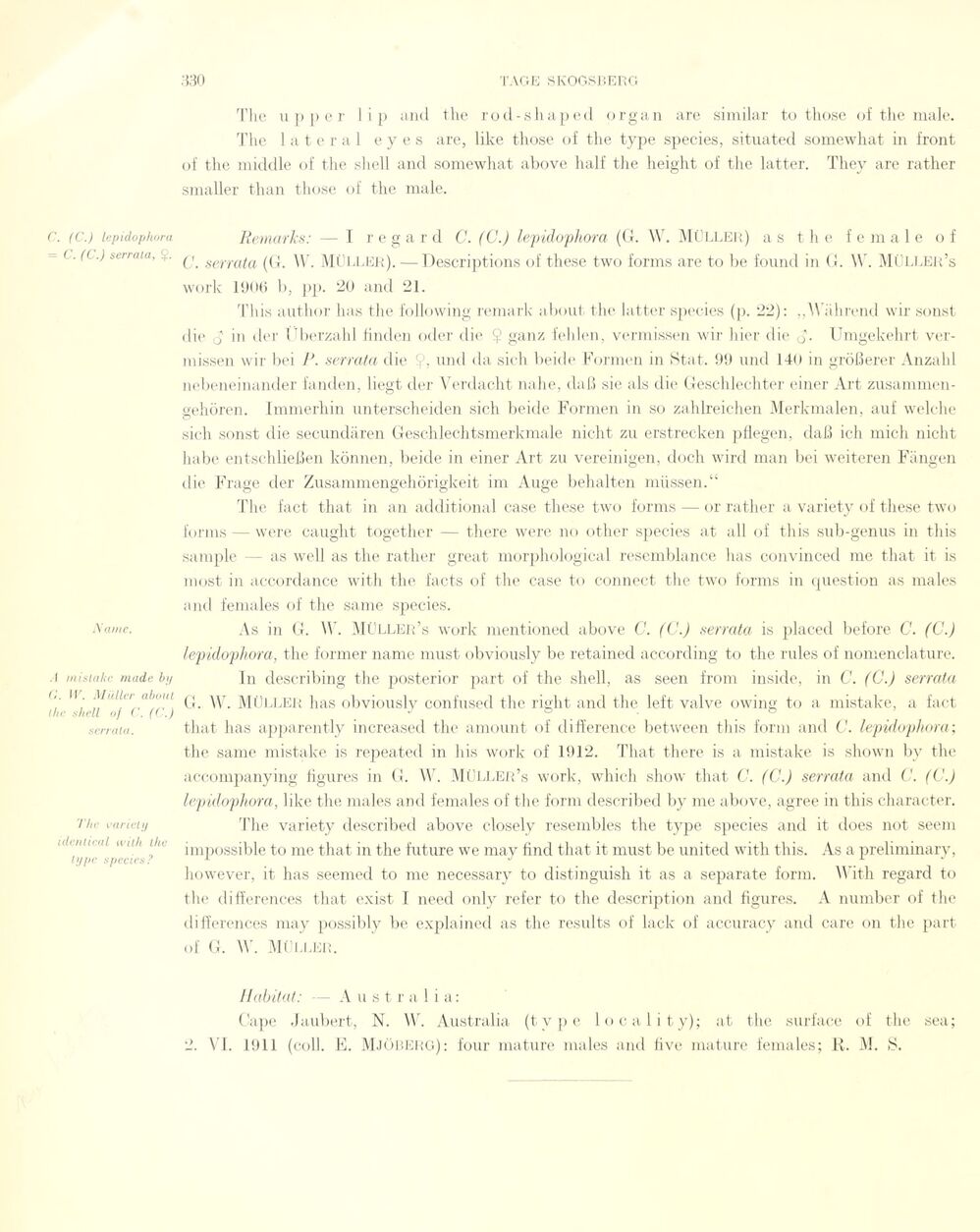
Full resolution (JPEG) - On this page / på denna sida - Sidor ...

<< prev. page << föreg. sida << >> nästa sida >> next page >>
Below is the raw OCR text
from the above scanned image.
Do you see an error? Proofread the page now!
Här nedan syns maskintolkade texten från faksimilbilden ovan.
Ser du något fel? Korrekturläs sidan nu!
This page has never been proofread. / Denna sida har aldrig korrekturlästs.
The u p p e r I i p and the rod-shaped organ are similar tothose of the male.
The lateral eyes are, like those of the type species, situated somewkat in front
of the middle of the shell and somewhat above half the height of the latter. They are rather
smaller than those of the male.
C. (C.) lepidophora
= C. (C.) serrata, $.
.Xante.
A mistake made by
C. W. Müller about
the shell of C. (C.)
serrata.
The variciy
identical wilh the
type species?
Remarks: — 1 regard C. (C.) lepidophora (G. W. MÜLLER) as the fe male of
C. serrata (G. W. Müller).—Descriptions of these two forms are to be found in G. W. MULLER’s
work 1906 b, pp. 20 and 21.
This author has the following remark about the latter species (p. 22): „Während wir sonst
die d i» der Überzahl finden oder die $ ganz fehlen, vermissen wir hier die d- Umgekehrt
vermissen wir bei P. serrata die ?, und da sich beide Formen in Stat. 99 und 140 in größerer Anzahl
nebeneinander fanden, liegt der Verdacht nahe, daß sie als die Geschlechter einer Art
zusammengehören. Immerhin unterscheiden sich beide Formen in so zahlreichen Merkmalen, auf welche
sich sonst die secundären Geschlechtsmerkmale nicht zu erstrecken pflegen, daß ich mich nicht
habe entschließen können, beide in einer Art zu vereinigen, doch wird man bei weiteren Fängen
die Frage der Zusammengehörigkeit im Auge behalten müssen.“
The faet that in an additional case these two forms — or rather a variety of these two
forms — were caught together — there were no other species at all of this sub-genus in this
sample — as well as the rather great morphological resemblance has convinced me that it is
most in accordance with the facts of the case to connect the two forms in question as males
and females of the same species.
As in G. W. MÜLLER’s work mentioned above C. (C.) serrata is placed before C. (C.)
lepidophora, the former name must obviously be retained according to the rules of nomenclature.
In describing the posterior part of the shell, as seen from inside, in C. (C.) serrata
G. W. MÜLLER has obviously confused the right and the left valve owing to a mistake, a faet
that has apparently inereased the amount of difference between this form and C. lepidophora;
the same mistake is repeated in his work of 1912. That there is a mistake is shown by the
accompanying figures in G. W. MÜLLER’s work, which show that C. (C.) serrata and C. (C.)
lepidophora, like the males and females of the form described by me above, agree in this character.
The variety described above closely resembles the type species and it does not seem
impossible to me that in the future we may find that it must be united with this. As a preliminary,
however, it has seemed to me necessary to distinguish it as a separate form. With regard to
the differences that exist I need only refer to the description and figures. A number of the
differences may possibly be explained as the results of lack of accuracy and care on the part
of G. W. Müller.
Habitat: — Australi a :
Cape Jaubert, N. W. Australia (type local i t y) ; at the surface of the sea;
2. VI. 1911 (coli. E. Mjüberg): four mature males and five mature females; K. M. S.
<< prev. page << föreg. sida << >> nästa sida >> next page >>